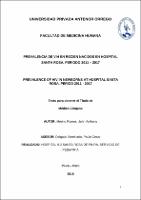| dc.contributor.advisor | Delgado Seminario, Paulo Cesar | |
| dc.contributor.author | Merino Ramos, John Anthony | |
| dc.creator | Merino Ramos, John Anthony | |
| dc.date.accessioned | 2019-03-22T08:41:24Z | |
| dc.date.available | 2019-03-22T08:41:24Z | |
| dc.date.issued | 2019 | |
| dc.identifier.uri | https://hdl.handle.net/20.500.12759/4602 | |
| dc.description.abstract | Desde su aparición hasta la actualidad, la infección por el VIH continúa siendo uno de los principales problemas de salud pública a nivel mundial. La transmisión vertical de madres a hijos es importante en los países en vías de desarrollo, puede ocurrir por 03 vías: Intrautero, Intraparto y Post natal. No obstante, el diagnóstico precoz y la adopción de medidas profilácticas durante el embarazo, parto, puerperio y el recién nacido, son fundamentales para su prevención. El Perú, en el 2004 asumió el compromiso de reducir a menos del 2% la transmisión materno infantil del VIH.
Objetivos: Determinar la prevalencia de VIH en recién nacidos de madres VIH positivas. Material y métodos: Diseño descriptivo, observacional, analítico y retrospectivo. Resultados: La prevalencia de VIH en recién nacidos fue 2,00%; de 100 partos registrados, el 5,00% fue por parto vaginal y el 95,00% por cesárea; el tratamiento antirretroviral cubrió el 99,0%; el 100,0% de las gestantes recibieron control prenatal; el 99,00% de recién nacidos recibieron tratamiento antirretroviral. Conclusiones: Se encontró una baja prevalencia de VIH en recién nacidos; se evidencia una buena cobertura de atención a las gestantes VIH positivas durante la etapa prenatal, tamizado, control antirretroviral a la madre y al recién nacido. | es_PE |
| dc.description.abstract | Since the first cases of Human Immunodeficiency Virus (HIV) were reported until today, this condition remains as one of the most serious health and development problems around the world. Mother-to-child transmission (MTCT), also known as “vertical transmission” is significant in developing countries and may occur through intrauterine, intrapartum or postpartum infection. However, early diagnoses and the adoption of prophylactic measures during pregnancy, childbirth, and new born stages are fundamental to prevention and control of infection risk. In 2004, Peru assumed the compromise of reducing at least 2% of mother -to- child transmission of HIV.
Objective: To determine the prevalence of HIV infection among infants born from HIV seropositive mothers.
Materials and Methods: Descriptive, observational, analytical and retrospective designed studies.
Results: The prevalence of HIV- infected new born babies was 2.00% of 100 registered births, 5.00 % of them were due to vaginal delivery while 95% were through cesarean delivery. Antiretroviral treatment coverage was 99%, 100% of pregnant HIV- infected women received prenatal care and 99% of new born received post-natal antiretroviral treatment
Conclusions: A low prevalence of HIV-infected new born babies was found, an evidence of a good care coverage in HIV-seropositive women during prenatal period and antiretroviral treatment in pregnant HIV -infected women and their newborns. | en_US |
| dc.description.uri | Tesis | es_PE |
| dc.format | application/pdf | es_PE |
| dc.language.iso | spa | es_PE |
| dc.publisher | Universidad Privada Antenor Orrego - UPAO | es_PE |
| dc.relation.ispartofseries | T_MEDP_071 | |
| dc.rights | info:eu-repo/semantics/openAccess | es_PE |
| dc.source | Universidad Privada Antenor Orrego | es_PE |
| dc.source | Repositorio Institucional - UPAO | es_PE |
| dc.subject | Transmisión vertical | es_PE |
| dc.subject | Antirretroviral | es_PE |
| dc.title | Prevalencia de VIH en recien nacidos en Hospital Santa Rosa, período 2011- 2017 | es_PE |
| dc.type | info:eu-repo/semantics/bachelorThesis | es_PE |
| thesis.degree.level | Título Profesional | es_PE |
| thesis.degree.grantor | Universidad Privada Antenor Orrego. Facultad de Medicina Humana | es_PE |
| thesis.degree.name | Médico Cirujano | es_PE |
| thesis.degree.discipline | Medicina Humana | es_PE |

